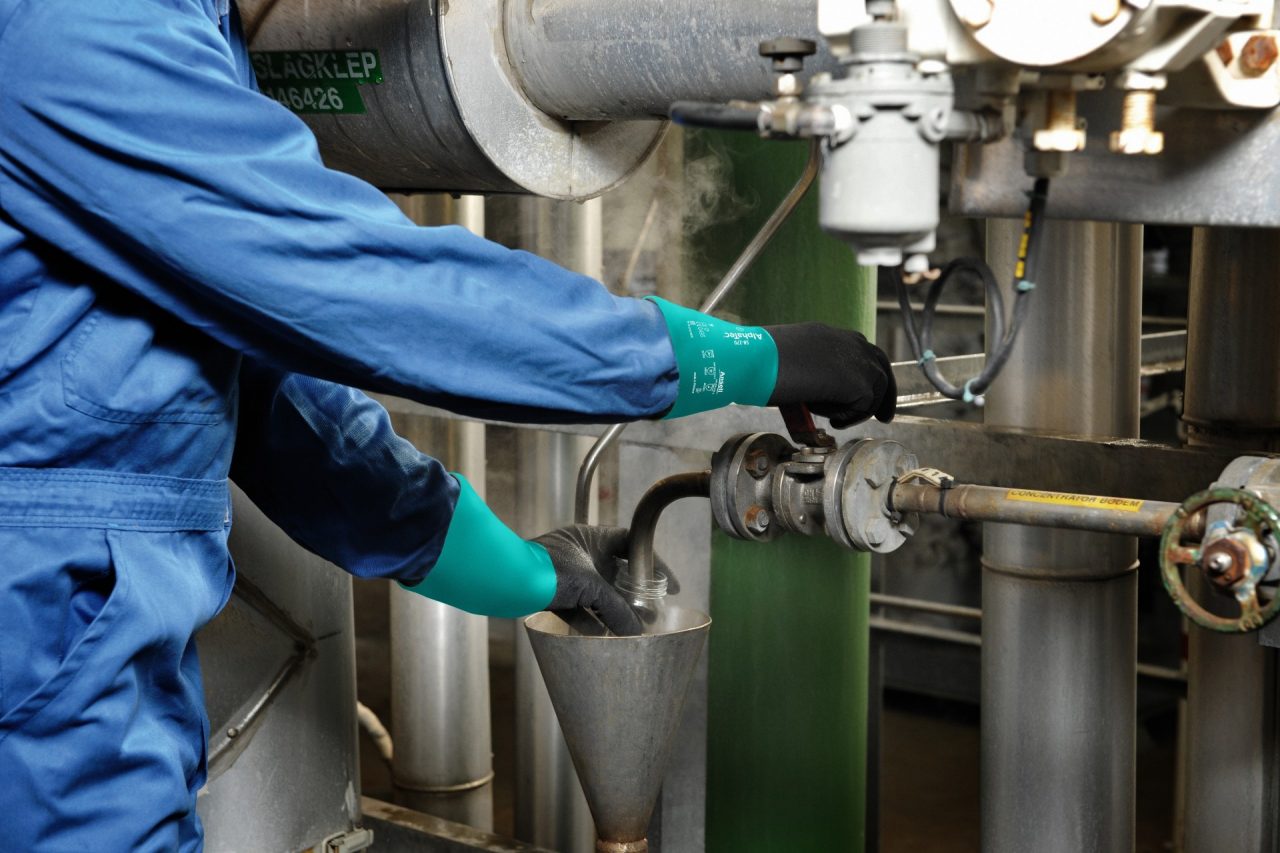EN 374 chemical, micro-organism and virus gloves
How to choose EN 374 chemical, micro-organism and virus gloves
BS EN ISO 374:2016+A1:2018 (EN 374 in short) is a worldwide standard for gloves that protect you when working with harmful chemicals and/or micro-organisms. Making sure you are protected against irreversible health damage. And possible legal consequences for your company.
Medical and legal consequences
Not wearing the right protective gloves can lead to serious, irreversible harm. Such as skinburn, dermatitis or other types of chronic injury. Which can result into job loss and working disability for the employee.
Wearing the right protective gloves when working with chemicals and/or micro-organisms, is crucial for both your employees and the overall company. That’s where the EN 374 standard comes in.

EN 374 standard
The full standard title is BS EN ISO 374:2016+A1:2018. The standard is currently divided into five levels (link also has a technical guide download, describing the standard), each standing for a specific type of testing and application:
- BS EN ISO 374-1:2016+A1:2018
Performance requirements for chemical risks - BS EN 374-2:2019+A1:2018
Determination to resistance to penetration - EN 16523-1:2015+A1:2018 (formerly EN 374-3:2003)
Determination of material resistance to permeation by chemicals, permeation by liquid chemical under conditions of continuous contact - BS EN 374-4:2019+A1:2018
Determination of resistance to degradation by chemicals - BS EN ISO 374-5:2016+A1:2018 (+ ISO16604 / Method B)
Protection against bacteria, fungi and virus
The more common term for the standard is EN 374. The abbreviations EN 374-1 up to 374-5 are also often used for each level within the standard.
First consideration: application
The type of EN 374 gloves you need, completely depends on your application. And additional to chemical resistance, you may also need protection from other hazards. Such as cut-resistance (EN 388) or heat protection (EN 407).
A risk assessment from your company’s Health & Safety Officer will help you to consider all options and make the right choice for hand protection.
Chemical-resistant gloves
For chemical-resistant gloves, the EN 374 standard guarantees testing in terms of permeation, penetration and degradation:
- Permeation: The rubber and plastic films in gloves are the barriers to chemicals. It is therefore necessary to measure breakthrough times, or the time taken for the hazardous liquid to come in contact with the skin. A chemical-resistant glove shouldn't leak when tested with air and water. If the length of the chemical protective glove is ≥ 40 cm, the cuff area must also be tested for permeation.
- Penetration: The movement of a chemical or other micro-organism through porous materials, seams, pinholes or other imperfections in a protective glove material at a non-molecular level.
- Degradation: Sometimes chemical protective gloves can act as sponges, soaking up the liquids and holding them against the skin. This degrades the glove. Indications of degradation are flaking, swelling, disintegration, embrittlement, colour change, dimensional change, change in appearance, hardening, softening and so on. The change of puncture resistance after chemical contact should be tested for all claimed chemicals on the glove and the result mentioned in the instructions for use.

These 18 chemicals are used for testing:
Code letter
Defined chemical
CAS number
Class
A
Methanol
67-56-1
Primary alcohol
B
Acetone
67-64-1
Ketone
C
Acetonitrile
75-05-8
Nitrile Compound
D
Dichlorometane
75-09-2
Chlorinated hydrocarbon
E
Carbon disulphide
75-15-0
Sulphur containing organic compound
F
Toluene
108-88-3
Aromatic hydrocarbon
G
Diethylamine
109-89-7
Amine
H
Tetrahydrofuna
109-99-9
Heterocyclic and ether compound
I
Ethyl acetate
141-78-6
Ester
J
n-Heptane
142-82-5
Saturated hydrocarbon
K
Sodium hydroxide 40%
1310-73-2
Inorganic base
L
Sulphuric acid 96%
7664-93-9
Inorganic mineral acid, oxidizing
M
Nitric acid 65%
7697-37-2
Inorganic mineral acid, oxidizing
N
Acetic acid 99%
64-19-7
Organic acid
O
Ammonia 25%
1336-21-6
Organic base
P
Hydrogen peroxide 30%
7722-84-1
Peroxide
S
Hydrofluoric acid 40%
7664-39-3
Inorganic mineral acid
T
Formaldehyde 37%
50-00-0
Aldehyde
When determining permeation level for chemicals to work with, each chemical tested is classified in terms of breakthrough time performance class 0 to 6.
Measured breakthrough time & protection index (PI):
- >10 minutes breakthrough time - Class 1 PI
- >30 minutes breakthough time - Class 2 PI
- >60 minutes breakthough time - Class 3 PI
- >120 minutes breakthough time - Class 4 PI
- >240 minutes breakthough time - Class 5 PI
- >480 minutes breakthough time - Class 6 PI
In combination with the specific chemicals used for testing, chemical-resistant gloves are also categorized with type A, B or (at least) C:
- Type A: Protective glove with permeation resistance of at least 30 minutes with at least six test chemicals.
- Type B: Protective glove with permeation resistance of at least 30 minutes with at least three test chemicals.
- Type C: Protective glove with permeation resistance of at least 10 minutes with at least one test chemical.
WARNING: The chemical data information doesn't necessarily reflect the actual duration in the workspace.
Micro-organism / virus protective gloves
When choosing micro-organism protective gloves, the EN 374 guarantees testing in terms of penetration and virus protection:
- Penetration: Micro-organism protective gloves have the same requirements as chemical gloves, if protection against bacteria and fungi is claimed. If the length of the chemical protective glove is ≥ 40 cm, the cuff area must also be tested for virus penetration.
- Virus protection: These gloves have an additional test as per ISO 16604, if virus protection is claimed.
WARNING: The chemical data information doesn't necessarily reflect the actual duration in the workspace.
EN 374 marking for chemical protective gloves
The chemical resistant glove pictogram must be accompanied by digit code letters for Type A and Type B gloves. Type C marked gloves are without any digit code letter. These code letters refer to a list of chemicals defined by the standard.
Specific product marking should include:
- CE mark and ID (and/or UKCA, due to Brexit)
- notified (or approved) body
- care and storage instructions
- instructions and limitations of use
- degradation results on claimed chemicals
- a list of substances used in the glove which are known to cause allergies
- name and address of body that certified the product.
NOTE: A list of all substances in the glove should be made available upon request. For our gloves, this information is included on each specific product page.



EN 374 marking for micro-organism protection gloves
Marking as per EN 374-5: For gloves protective against bacteria and fungi, the biohazard pictogram is applied. For this, the protective glove must be tested according to EN374-2:2013 for leakage proofness.
For protection against bacteria, fungi and virus, the biohazard pictogram is accompanied with the term "VIRUS" underneath. For this protective standard, the glove must be tested according to EN374-2:2013 for bacteria and fungi and tested according to ISO16604:2014 (Method B) using the bacteriophage penetration test.
NOTE: With this standard, protective gloves against micro-organisms can be claimed with or without chemical protection and vice versa.


Glove material and size
The quality, thickness and permeability of the glove materials dictate their level of protection against specific chemicals. However, because each material resists or reacts differently to different chemicals, there is no universal glove able to protect against all chemicals. Common materials for EN 374 gloves are nitrile, latex and PVC.
Nitrile gloves
- Synthetic rubber with good abrasion resistance.
- Excellent protection against most chemicals, expect for ketones.
- Efficient protection against harsh chemicals and solvents, mineral and vegetable oils, gasoline and diesel fuel, grease and many acids.
- Good alternative for people with latex allergies.
- Natural rubber with great comfort, elasticity and adaptability.
- Ideal for precision tasks.
- Suitable for handling inorganic chemicals and with most solvents.
- Good protection against infections.
- Less efficient against petroleum-derived compounds, aromatic solvents, oils, fats, dairy products, or minerals and vegetables.
- Synthetic thermoplastic polymer with good abrasion resistance.
- Verry efficient against acids, oils and greases.
- Very poor in creating a barrier against organic solvents.
Choosing glove size
Not sure what glove size to choose? This table will help you decide:
Intermediate sizes are optional too. As well smaller or bigger sized than shown in this table.
Glove size
Hand size
Hand circumference/ length (mm)
Minimal glove length (mm)
6
6
152/160
220
7
7
178/171
230
8
8
203/192
240
9
9
229/192
250
10
10
254/204
260
11
11
279/215
270
Other materials
Other materials include Butyl, Viton, EPDM and Neoprene.
Attention: combining 2 or more substances can change their chemical properties and their effects on the mentioned materials. If you select protection gloves for handling mixtures, you need to pay attention at the new permeation rates. In general, for mixtures, the glove should be selected based on the chemical component with the shortest breakthrough time.
More protective gloves advice
Application, substances used, glove material and size are the key factors when choosing EN 374 protective gloves. Are you still in doubt or would you like some thorough advice? Feel free to contact your local ERIKS glove specialist anytime.
General contact ERIKS Global Head Office
Chamber of Commerce
37 01 32 89
VAT Number
NL003.076.490.B02

